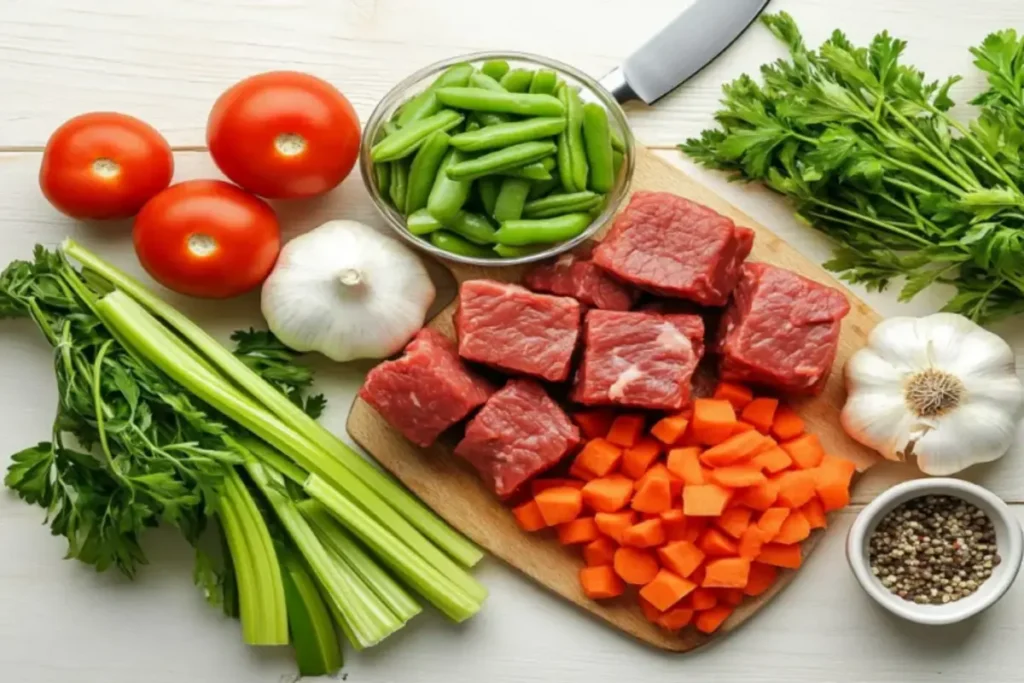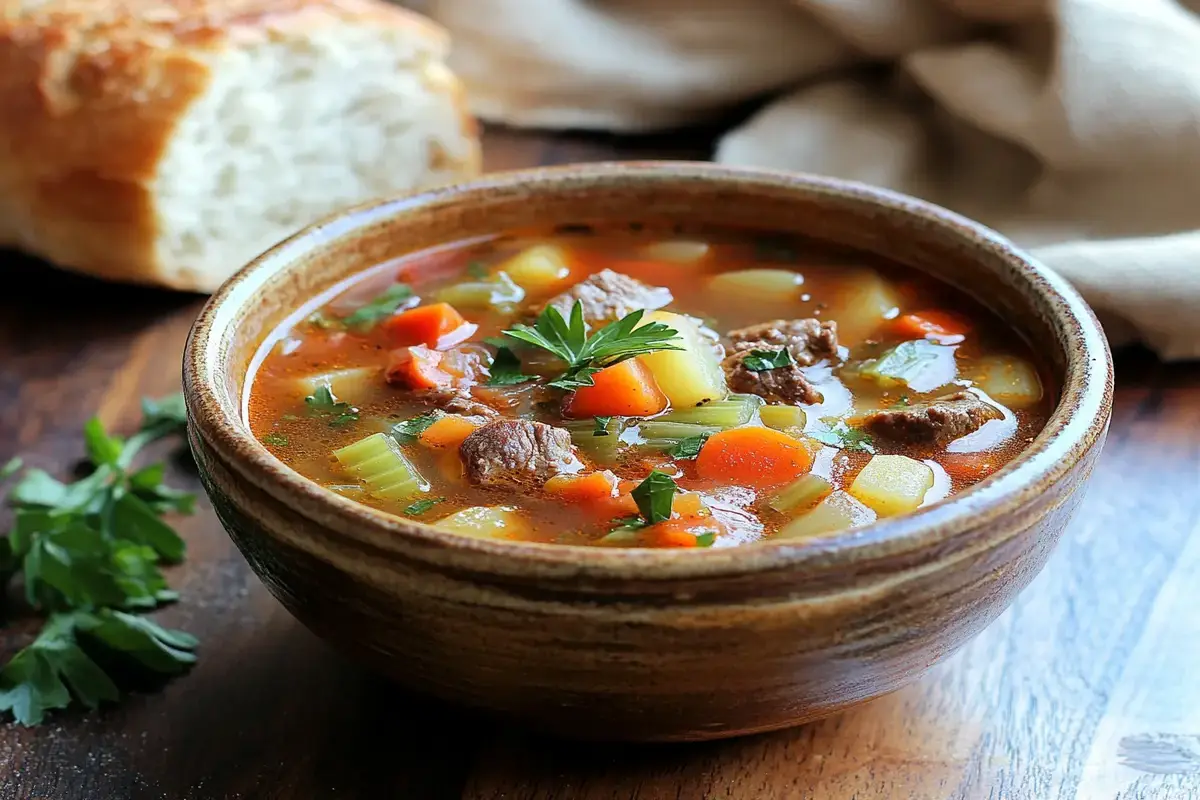There’s something undeniably comforting about a steaming bowl of vegetable beef soup. It’s the kind of meal that warms you from the inside out, whether you’re fighting off a cold, feeding a hungry family, or just craving something hearty. This guide covers everything you need to know—from choosing the right beef to layering flavors—so you can make a rich, satisfying soup every time.
What Makes Vegetable Beef Soup So Special?
At its core, vegetable beef soup is a simple yet deeply satisfying dish, combining slow-simmered beef, fresh vegetables, and a rich broth. While recipes vary across cultures—think French pot-au-feu or Asian-style beef soups—the magic lies in balancing textures, flavors, and seasonings.
The Key to Incredible Flavor
A great vegetable beef soup isn’t just about throwing everything into a pot and hoping for the best. It’s about layering flavors, using the right ingredients, and cooking with intention.
- Aromatics: Onions, garlic, and celery provide a savory base.
- Tomato Paste: Adds umami depth and a subtle sweetness.
- Herbs & Spices: Thyme, bay leaves, and rosemary bring warmth.
- Beef Selection: Chuck roast, shank, or brisket release rich collagen when simmered.
- Broth vs. Stock: Stock (especially homemade bone broth) provides a deeper, more luxurious mouthfeel.
How to Build Depth of Flavor in Your Soup

1. Start with a Flavorful Base
Sautéing onions, garlic, and celery in olive oil or butter before adding liquids unlocks their sweetness and creates a strong foundation. If you have extra time, roast your vegetables first for even more depth.
2. Brown the Beef for Extra Richness
Instead of boiling the beef right away, sear it in a hot pan to lock in juices and create caramelized flavor. This step, known as the Maillard reaction, makes a huge difference in the final taste.
How to Properly Brown Beef:
- Pat the beef dry before cooking (moisture prevents browning).
- Use a hot, lightly oiled pan and sear in batches.
- Let it sit undisturbed for a minute or two to form a golden crust.
3. Deglaze for a Boost of Flavor
After browning the beef, use broth, red wine, or vinegar to scrape up the flavorful bits stuck to the pan. This technique infuses the soup with an extra layer of richness.
4. Use the Right Liquid
- Broth: Light and subtle.
- Stock: Rich and full-bodied, perfect for slow-cooked soups.
- Bone Broth: Packed with collagen for a velvety texture.
5. Add Vegetables in Stages
Not all vegetables cook at the same rate! For the best texture:
- Add carrots, potatoes, and celery early (they need time to soften).
- Stir in peas, green beans, or spinach near the end to keep them vibrant.
Learn more about fresh vs. frozen vegetables and how they affect texture.
6. Balance Sweetness and Acidity
A splash of vinegar or lemon juice brightens the soup and balances richness. If your soup tastes too acidic, a pinch of sugar or caramelized onions can mellow it out.
Best Cuts of Beef for Soup
Some cuts of beef become wonderfully tender when simmered, while others turn tough. Here’s what works best:
- Chuck Roast: Tender, flavorful, and perfect for slow cooking.
- Brisket: Rich and deeply beefy but requires a longer cook time.
- Shank or Oxtail: Adds gelatin for a silky, luscious broth.
Simple Step-by-Step Recipe for Classic Vegetable Beef Soup

Ingredients
- 1 ½ lbs chuck roast, cut into 1-inch cubes
- 2 tbsp olive oil
- 1 onion, diced
- 3 cloves garlic, minced
- 2 carrots, sliced
- 2 celery stalks, chopped
- 1 can (14 oz) diced tomatoes
- 6 cups beef broth or stock
- 2 potatoes, diced
- 1 cup green beans, chopped
- 1 tsp thyme
- 1 bay leaf
- Salt & pepper to taste
Instructions
- Brown the Beef: Heat olive oil in a large pot over medium-high heat. Sear beef cubes until browned on all sides. Remove and set aside.
- Sauté Aromatics: In the same pot, cook onions, garlic, carrots, and celery until softened.
- Deglaze the Pan: Add a splash of broth or red wine, scraping up browned bits from the bottom.
- Simmer: Return the beef to the pot, add diced tomatoes, broth, potatoes, thyme, and bay leaf. Bring to a boil, then reduce heat and simmer for 1.5-2 hours.
- Add Final Ingredients: Stir in green beans during the last 10 minutes of cooking.
- Taste & Adjust: Add salt, pepper, or a splash of vinegar for balance. Remove bay leaf before serving.
Creative Twists & Global Variations
- French Pot-au-Feu: A simple but elegant beef-and-vegetable soup served with crusty bread and Dijon mustard.
- Asian-Style Beef Soup (Pho Bo): Add soy sauce, ginger, and bok choy for a comforting umami boost.
- Mexican Caldo de Res: Incorporate poblano peppers, cumin, and fresh cilantro for a bold, spicy twist.
Storing & Freezing Tips
- How to Freeze: Store soup in airtight containers and freeze for up to 3 months.
- Reheating: Warm over medium heat, adding extra broth if needed.
Final Thoughts
Vegetable beef soup is the ultimate comfort food—simple, nourishing, and endlessly customizable. Whether you’re making a traditional version or experimenting with global flavors, the key is layering flavors and using quality ingredients.
Try this recipe, tweak it to your taste, and let me know how it turns out! What’s your favorite way to make vegetable beef soup?

